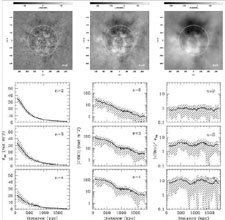


We have seen that cluster magnetic field strengths can be calculated
through their effects on the polarization properties of radio galaxies
by using an analytical formulation
(Sec. 3.5.2) based on the
approximation that the magnetic field is tangled on a single scale.
However, detailed observations of radio sources and MHD simulations
[144,
145,
161]
suggest that it is necessary to consider more
realistic cluster magnetic fields which fluctuate over a wide range of
spatial scales. To accomplish this, Murgia et al.
[146]
simulated random three-dimensional magnetic fields with a power-law
power spectrum: | B |2
|2

 -n, where
-n, where
 represents the wave
number of the fluctuation scale. They
investigated the effects of the expected Faraday rotation on the
polarization properties of radio galaxies and radio halos, by
analyzing the rotation measure effects produced
by a magnetic field with a
power spectrum which extends over a large range of spatial scales
(6 - 770 kpc) and with different values of the spectral index
(n = 2, 3, 4).
represents the wave
number of the fluctuation scale. They
investigated the effects of the expected Faraday rotation on the
polarization properties of radio galaxies and radio halos, by
analyzing the rotation measure effects produced
by a magnetic field with a
power spectrum which extends over a large range of spatial scales
(6 - 770 kpc) and with different values of the spectral index
(n = 2, 3, 4).
10.1. Simulated rotation measures
Fig. 10 (top) shows the
simulated RM images obtained with different values
of the index n for a typical cluster of galaxies (see caption for
more details). Different power spectrum indexes will generate
different magnetic field configurations and therefore will give rise
to very different simulated RM images. Fig. 10
(bottom) shows the simulated profiles of
 RM,
|<RM>|, and |<RM>| /
RM,
|<RM>|, and |<RM>| /
 RM (left,
central and right panels, respectively), as a function of the projected
distance from the cluster center. While both
RM (left,
central and right panels, respectively), as a function of the projected
distance from the cluster center. While both
 RM and
|<RM>| increase linearly with
the cluster magnetic field strength, the ratio |<RM>| /
RM and
|<RM>| increase linearly with
the cluster magnetic field strength, the ratio |<RM>| /
 RM depends
only on the magnetic field power spectrum slope, for a given range of
fluctuation scales. Therefore the comparison between RM data of
radio galaxies embedded in a cluster of galaxies and the simulated
profiles, allows the inference of both the strength and the power
spectrum slope of the cluster magnetic field.
RM depends
only on the magnetic field power spectrum slope, for a given range of
fluctuation scales. Therefore the comparison between RM data of
radio galaxies embedded in a cluster of galaxies and the simulated
profiles, allows the inference of both the strength and the power
spectrum slope of the cluster magnetic field.
 |
Figure 10. Top: simulated RM images for
magnetic field power spectrum spectral index n = 2, 3, 4.
The electron gas density of the cluster follow a standard
|
Typical measured values of |<RM>| /
 RM for
cluster radio galaxies are derived to be in the
range 0.2 - 1.2, once the Galaxy contribution is subtracted
[146].
Thus the comparison of the observations with the simulations
leads to a rather flat cluster magnetic field power
spectrum, with a spectral index
n
RM for
cluster radio galaxies are derived to be in the
range 0.2 - 1.2, once the Galaxy contribution is subtracted
[146].
Thus the comparison of the observations with the simulations
leads to a rather flat cluster magnetic field power
spectrum, with a spectral index
n  2. This
indicates that most of the magnetic energy density is on the smaller scales.
2. This
indicates that most of the magnetic energy density is on the smaller scales.
Another result of the simulations is that, when a power spectrum
of the magnetic field is assumed, the inferred magnetic field strength
is about a factor of 2 lower than the value computed
from Eq. 46 if the single scale
 c is
taken to be equal to the smallest
patchy structures detectable in the RM images, as frequently used.
This implies that the magnetic fields derived from RM measurements
may be overestimated (see Sec. 9).
c is
taken to be equal to the smallest
patchy structures detectable in the RM images, as frequently used.
This implies that the magnetic fields derived from RM measurements
may be overestimated (see Sec. 9).